The Women’s World Cup in 2019 drew a huge amount of interest and was instrumental in increasing exposure of the women’s game to the wider world. Now, three years later, international women’s football once again takes centre stage, with the UEFA Euro 2022 finals in England promising to be an occasion to remember.
One of the teams competing in the finals tournament are Denmark, a side rich in talent who have regularly been ranked among the top nations in women’s football and currently hold 15th place in the world rankings. They have significant experience of major tournaments in the past, having been to four World Cups and ten Euro tournaments (including this one), and were the runners-up in the 2017 final, eventually losing out to hosts the Netherlands. They are no strangers to the top table.
However, in their group this time, they will face Finland, Germany and Spain, none of whom represent easy opposition. Spain are expected by many to top the group, but Germany and Denmark will most likely fight to finish second and join them in the tournament’s latter stages, whilst Finland are seen as the group’s underdogs and won’t be expected to progress. Given their tournament pedigree and squad quality, it is certain that the Danish side will attract plenty of focus from fans, who will be eager to see if they meet expectations or if they end up falling short.
Predicted Starting XI
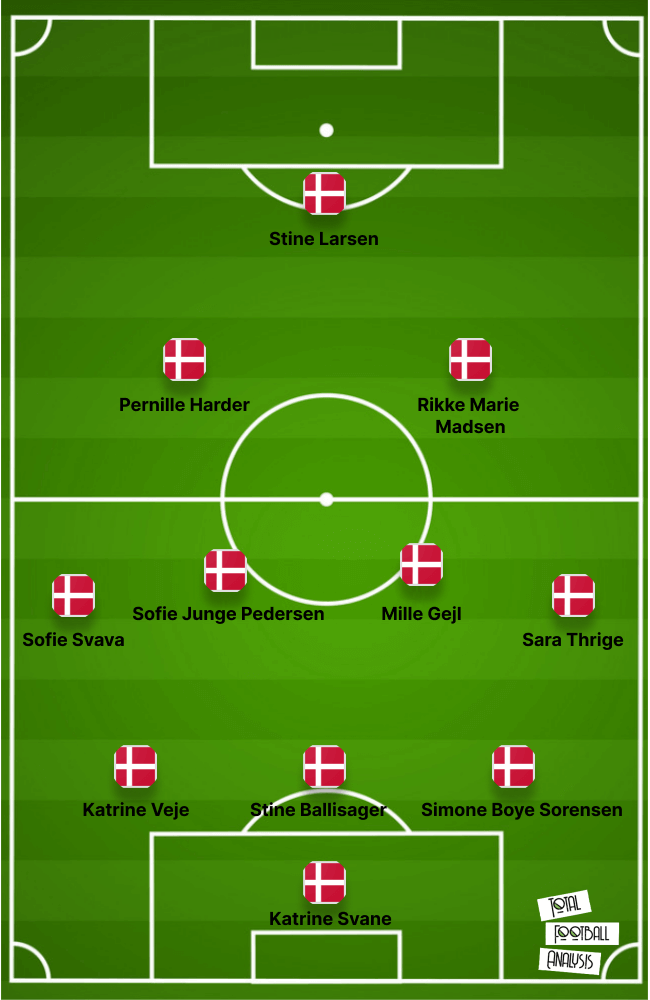
Denmark tend to favour a 3-4-2-1 setup during matches, with three strong defenders who are also capable of playing out from the back, wing-backs who can get up the pitch and create width for the team, midfielders who have a good level of energy and contribute in both offensive and defensive situations, and three forwards who can work together to keep attacks alive and then shoot at goal when the moment comes.
Katrine Svane will likely be their first-choice goalkeeper, with her closest competitor Lene Christensen included in the squad but still recovering from an injury sustained in the Algarve Cup back in February, so she may not be deemed fit to start their group games. The back three has been made up in more games than not during 2022 by Arsenal Women’s Simone Boye Sørensen, who is calm under pressure and capable of finding teammates in key areas ahead of her, Stine Ballisager, a reliable player that the team can fall back on if space becomes limited ahead of them, and Katrine Veje, who plays for Swedish giants Rosengård and, like Boye Sørensen, adds composure and quality to their back line.
The wing-back roles are not as settled, with several options available and Denmark coach Lars Søndergaard trying different players in the wide channels so far this year. However, the left is more certain, with Real Madrid Femenino’s Sofia Svava capable of playing as a winger or a left-back and therefore fitting the role perfectly. Meanwhile, the best option on the right, given her natural tendency to get into forward areas, is Milan Femmenile’s Sara Thrige Andersen, as her pace and crossing ability will be vital in their transitional play and ability to carry a presence in the final third.
Between those two players, there are again several combinations that could be used. However, given the need for players who are agile, spatially aware and always switched on, Mille Gejl and Sofie Junge Pedersen, of BK Häcken and Juventus Femmenile respectively, seem the most likely to start. Junge Pedersen has shown herself this season to be a reliable defensive player in Serie A Femmenile, helping the Italian champions to control matches from deeper positions, whilst Gejl is an all-rounder who has been seen linking up play and making runs into advanced areas of the field to support attacks, so would balance the midfield out.
The three forward positions are again debatable, with different ways for Denmark to create the perfect blend of ball control and goal threat. Chelsea Women star Pernille Harder has been injured for much of the last season, but there is a wide expectation that she will feature in one of the two supporting roles if fit enough to start. Alongside her, with Real Madrid Femenino’s Caroline Møller left out, Madrid CFF Femenino’s Rikke Marie Madsen looks most likely to be in the XI, helping Denmark to unlock defences when needed, whilst Stine Larsen is most likely to be named as their central striker. Larsen has become Häcken’s first-choice striker since joining the team from Aston Villa Women last summer and Denmark rarely go into a game without her.
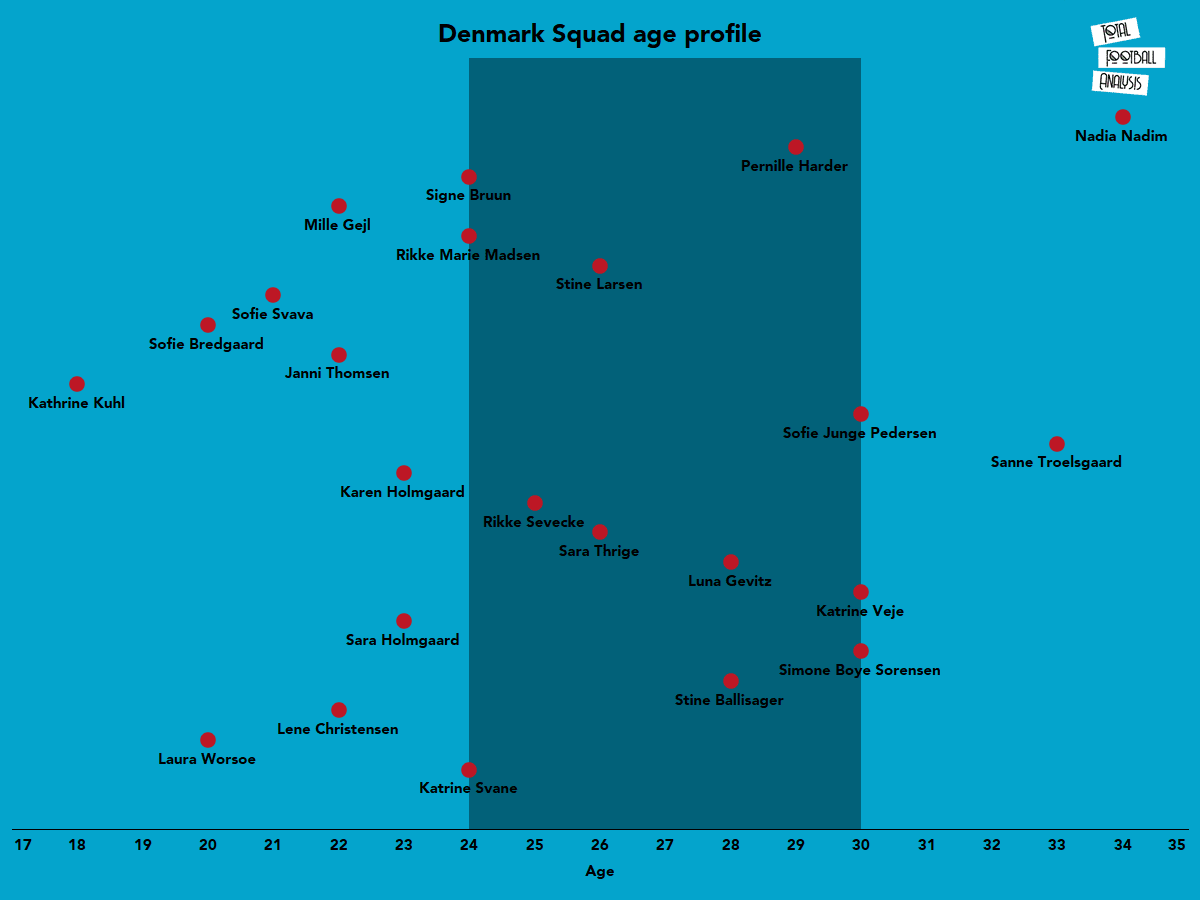
This graphic shows the spread of ages between those included in Denmark’s final squad for the tournament, separating the 23 players into youth (aged 24 and under), peak (24 to 30) and experienced (30 and over).
As can be seen, Denmark have generally favoured a more youthful approach to their squad selections, with the majority of players either in the youth or early peak categories, and this is likely because players in these age ranges have extra pace and raw ability, particularly in the middle of the pitch, which suits their creative free-flowing style of football.
However, in defence, they rely more on experience, with players who have been around the international team for longer likely to be included in the back three. This is perhaps to ensure that there is a tried and tested last line of defence and they have the ability to work together when required to end threats, providing defensive solidity and allowing those further forward to focus purely on what is ahead of them, which again leads to their positive attacking play.
Attacking phase
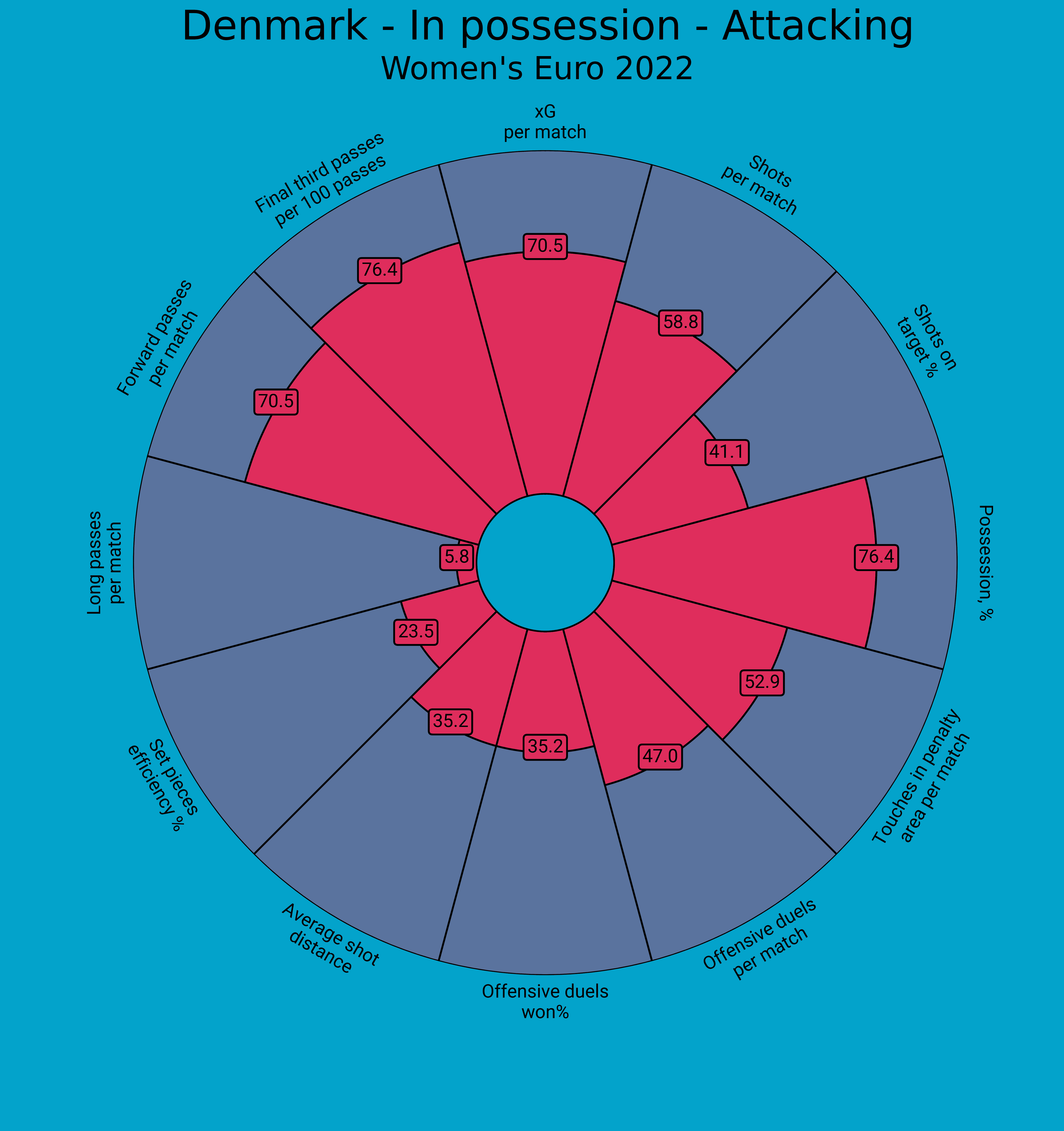
It’s evident from this graphic that Denmark play an attacking style of football that enables them to control games, as proven by their high percentile ranking in possession. This is a positive of their 3-4-2-1 system, as the structure allows each player to constantly have two or three options in different areas whenever they receive the ball, meaning that they can keep it moving and rarely give it away cheaply.
Due to their ability to control the flow of matches, it is unsurprising that they also make plenty of forward passes and passes into the final third, constantly looking to progress attacks and keep the pressure on their opponents. Moving the ball closer to their opponents’ goal and then making intelligent shot selection are the reasons why their average shot distance is much lower than other teams, and we can expect that they will not score many goals from long distance during the upcoming finals.
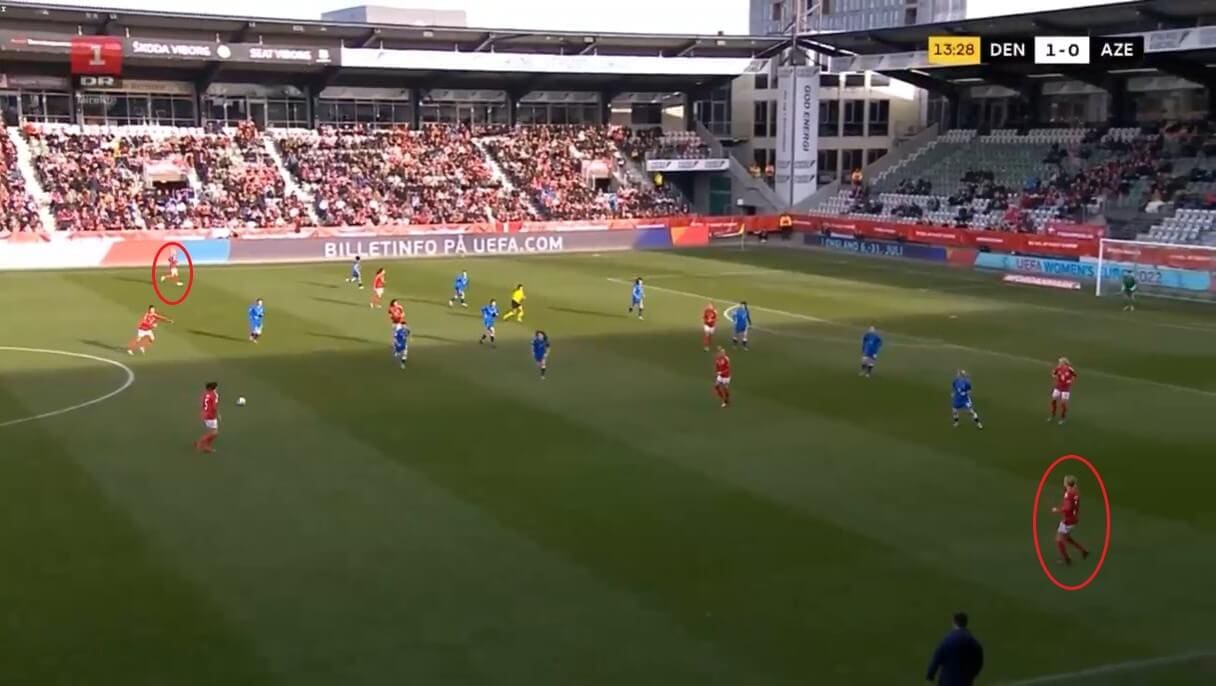
We have already mentioned in this tactical analysis that Denmark’s wing-backs play a key role in offensive situations, with their ability to hold the width shown in this situation against Azerbaijan. Both Sara Thrige and Sofie Svava have pushed up the pitch here, which means that the central midfielders and forward trio can work more closely to each other because none of them need to be concerned about the wings being left open. As a result, they can outnumber their opponents more easily, giving them a better chance of converting their opportunities when they opt to shoot.
The wing-backs are not only wide players, though, and are often seen drifting inside when Denmark get the ball into the goal area, often swapping positions with a teammate initially inside the pitch to become fully involved in the attack. With this in place, it is not surprising that Thrige has scored two goals and assisted three others for her country over the last year, whilst Svava has scored one and assisted eight.
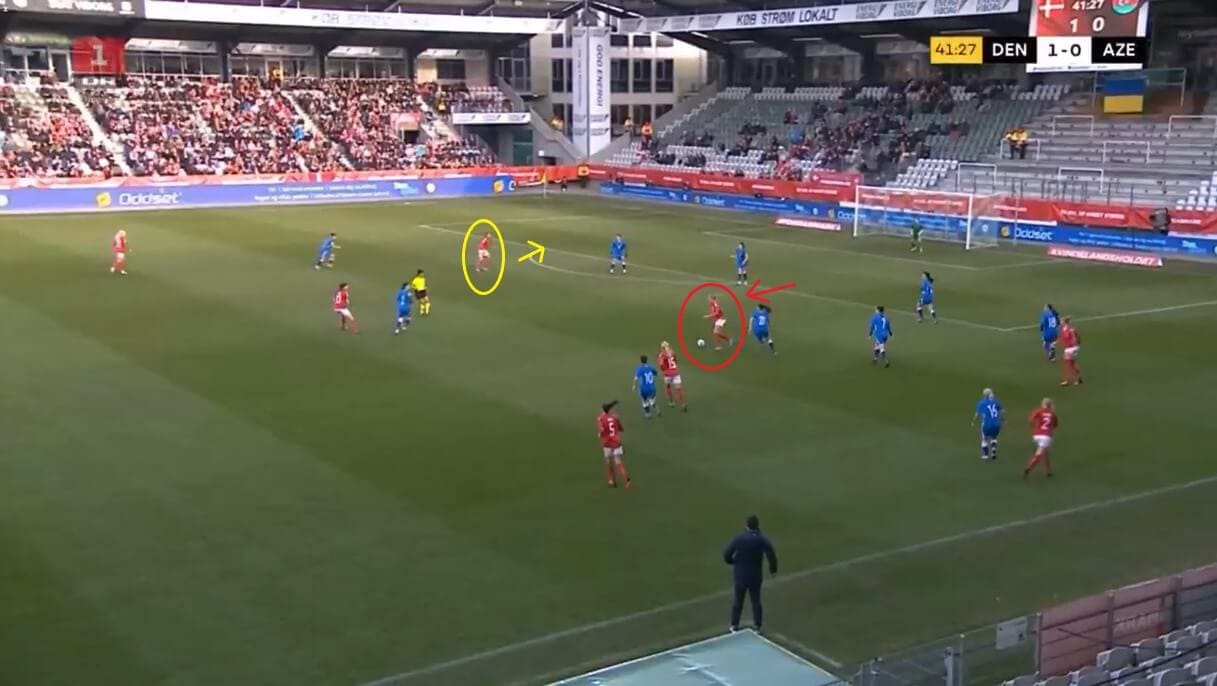
The flexibility that comes from players having freedom to move around the pitch also comes to light when looking at their midfield, with each player encouraged to find holes in and around their opponents and help to keep their play flowing, again ensuring that possession is maintained. In this case, Stine Larsen has dropped back and now has possession outside of the box, whilst Mille Gejl, in the yellow circle, is moving forward to take her place as the main target player.
If we refer back to the graphic at the beginning of this section, it is shown that Denmark don’t make many long passes per match; this is due to them always looking for shorter passes like the one into Larsen here because the risk of losing possession is lower and their opponents find it harder to make interceptions, which is something that Azerbaijan discovered in this game.
Therefore, in attack, Denmark are a clinical side who don’t make many mistakes and have a clear game plan that will make them very tricky opponents.
Defensive phase
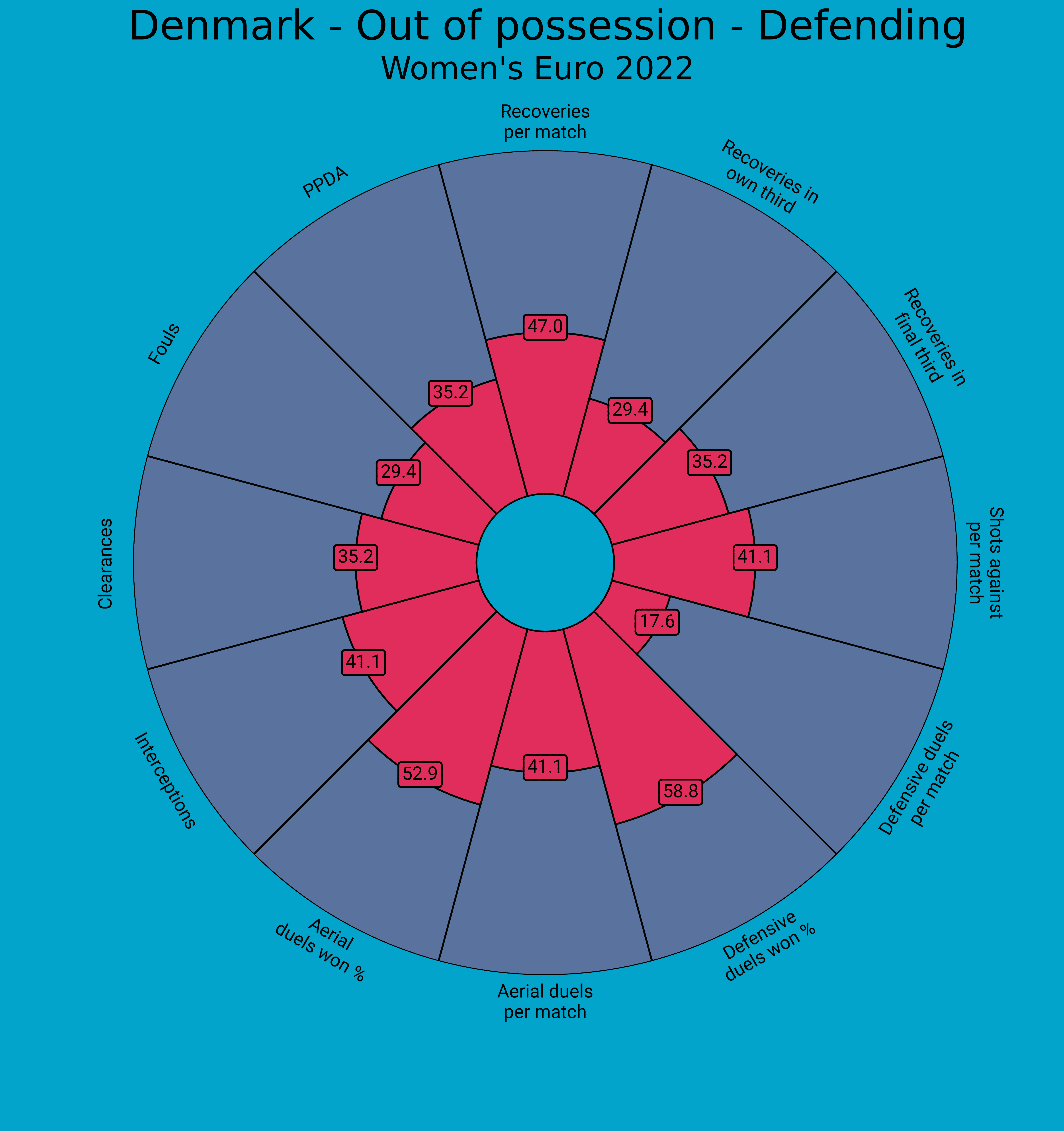
As a result of Denmark having numbers up the pitch, it is not surprising that they have a good ability to regain possession fairly rapidly once conceding it, with an average of 47 recoveries in their opponents’ half per match partially resulting from this. Compare that to the number of recoveries made in their own half and the point is clear — Denmark tend not to wait until their opponents have made territorial gains before looking to win back possession.
This is perhaps the reason for them not engaging in many defensive duels or aerial duels per game either, as indicated in the graphic. However, it should also be noted that the ones they do compete in tend to be successful, which shows that they are strong when they need to be and always have something to fall back on if possession is not regained as quickly as normal. What this means for Spain, Germany and Finland is that they will need to be calm when they do win the ball, because even if they manage to evade Denmark’s initial counterpress, the Danish players will not give up and allow them through.
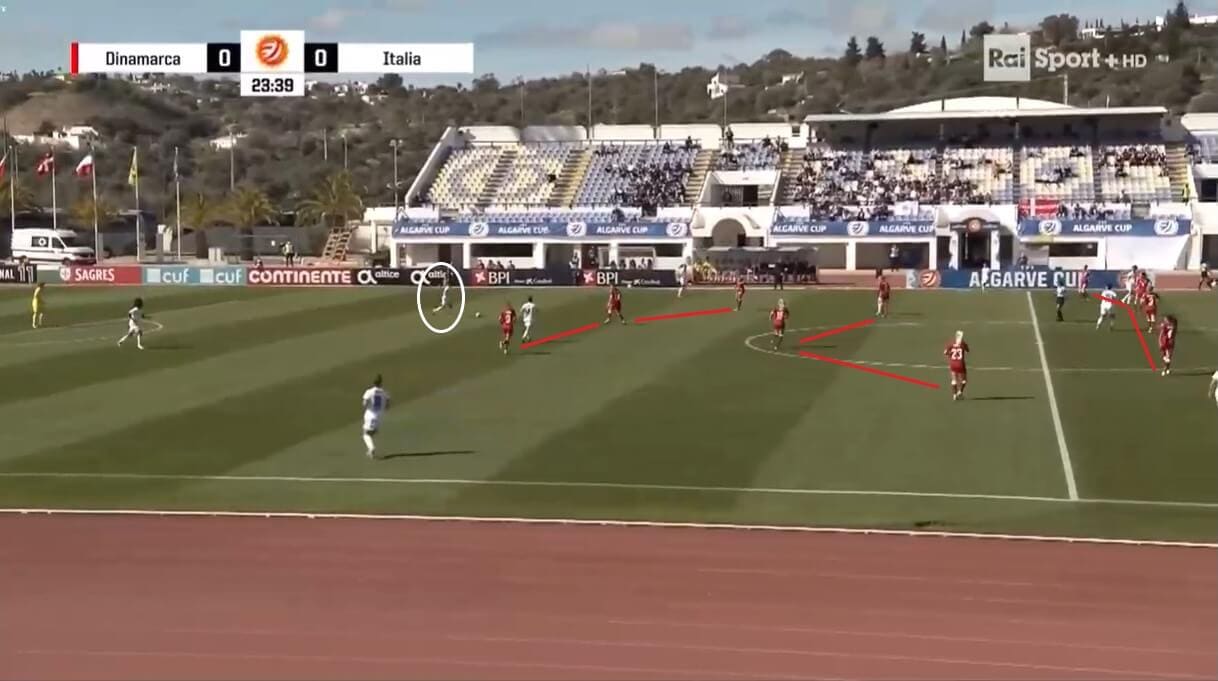
That comes from their team structure when out of possession, which is organised and turns into a rough 4-3-3 shape. Italy are looking to move up the field here, but this pre-planned structure means that it is hard for them to make any ground passes and instead they are forced to play a long aerial pass, targeting the area behind the Danish defensive line and making it easier for Denmark to regain the ball and end the threat.
As well as removing options from Denmark’s opponents, this setup also takes time away, as they can send players towards the ball in turn and force them to play the ball quicker, increasing the risk of a mistake being made. Going back to the graphic, opponents do manage to get a sizeable number of shots on Denmark’s goal, but only 41.1% are actually on target, and this shape is a big reason for that.
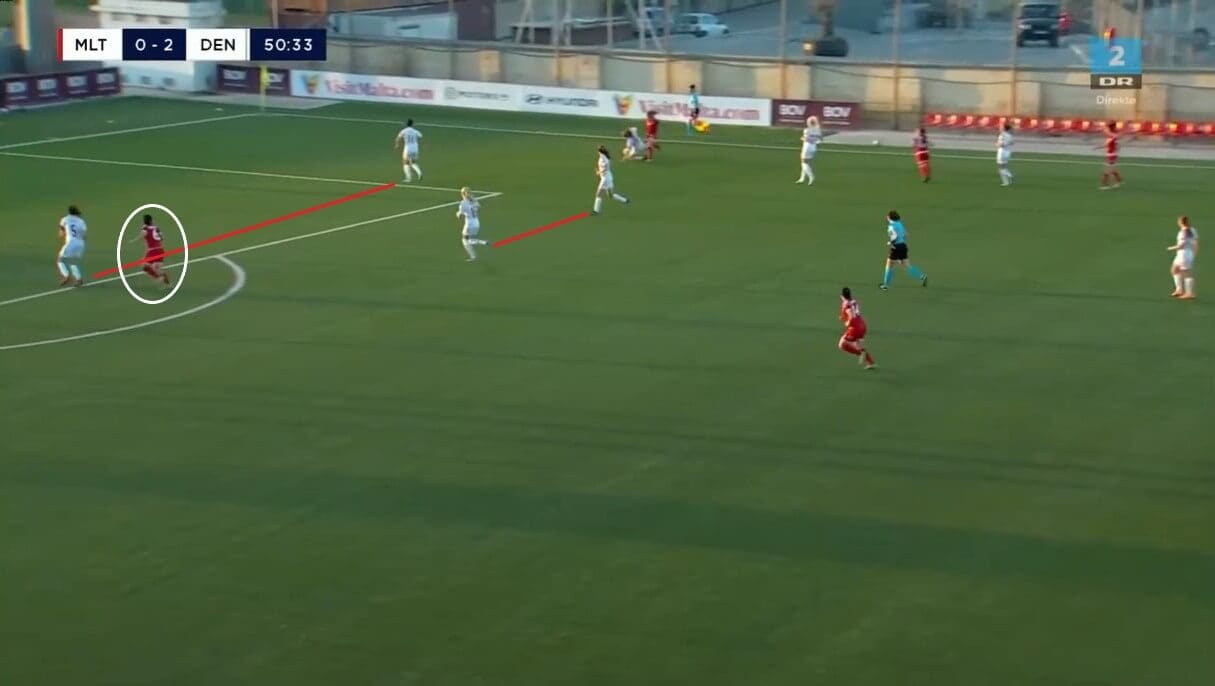
The other key aspect of their defensive tactics concerns the midfielders and defenders working together when the ball does get higher up the pitch, with their focus at this point turning towards limiting their opponents’ options in the middle. This is done by the back three becoming compact and protecting the goal whilst the two midfielders drop back to offer extra support and get tight to their teammates, leaving just a narrow corridor open for the central attacker to position themself in. Malta’s target player here now doesn’t pose a significant threat due to Denmark players working hard and helping each other out.
Therefore, as this section of the analysis has highlighted, Denmark once again have ways of adapting to win the ball back, and this is another reason why they will be tough to beat.
Transitions
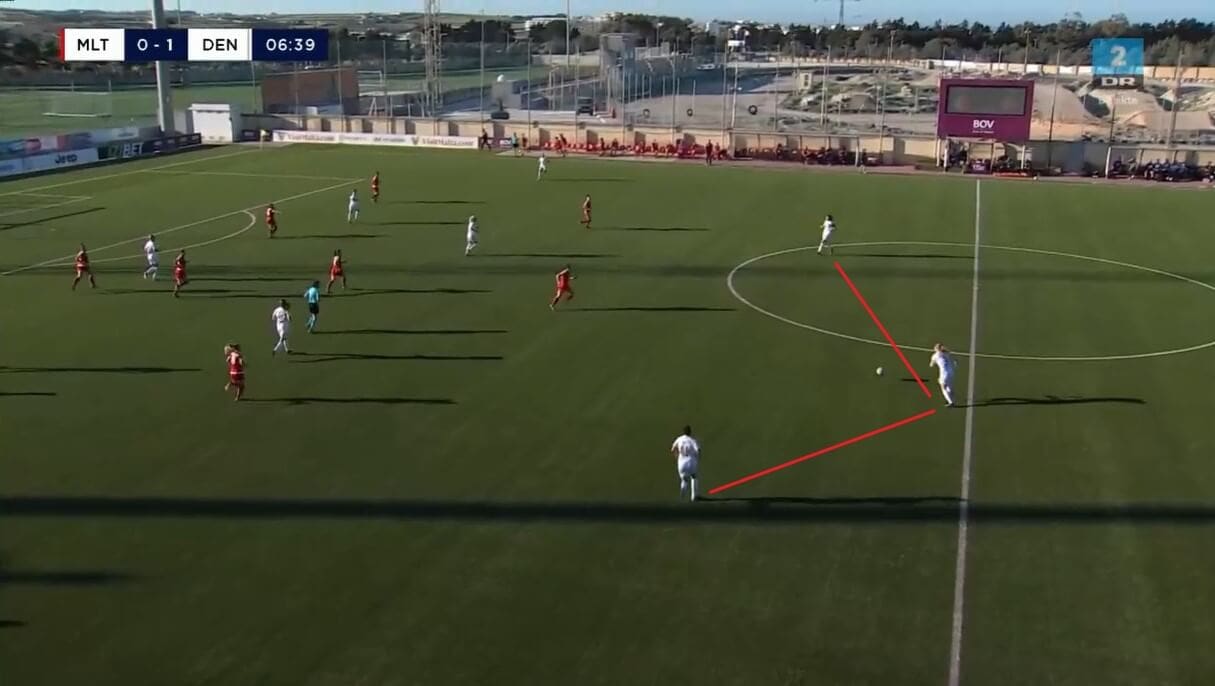
This scout report has already noted that the back three play just as important a role as the wing-backs in enabling Denmark to create numerical overloads in the final third, and this image shows how far up the pitch the defenders tend to position themselves when the team is on the offensive. What is always visible is their teamwork and communication, ensuring that they don’t move too far away from each other and can become compact whenever the team lose the ball.
The advantage of having these three players this high up the pitch is that Denmark can make decisions in possession, not only in terms of which player to give the ball to but also whether to make a ground or aerial pass. We have already noted that they prefer to keep it on the ground, but having the ability to play through the air is also important as it demonstrates the team’s adaptability and versatility.
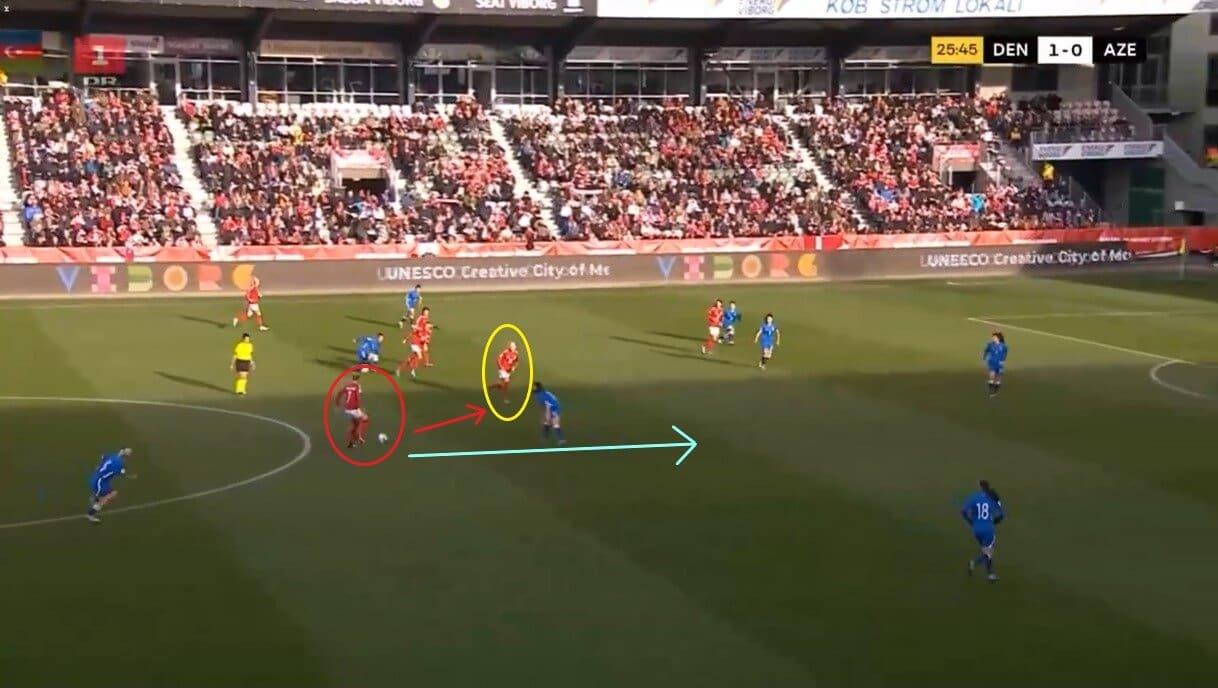
When the ball is played into the midfielders, they always want players to be available, as is a previously highlighted feature of their game plan. However, players never stand still once they have released the ball, with Reading Women’s Sanne Troelsgaard passing into Kathrine Kühl here and then instantly moving forwards to offer a return option — this comes back to their spatial awareness and desire to keep moving into holes around the pitch.
Given that they make plenty of passes and wait for the right moment to shoot rather than simply trying their luck, some might describe their style of play as laboured and slow. Whilst this may be true, it is a system that has worked for them and is one that the players are clearly well-tuned in, so we can expect it to be prominent during their performances at Euro 2022.
Forwards
As mentioned, the key roles of the forwards are to receive the ball and provide an end product. However, shooting is not their strongest point, which is perhaps why they wait longer than might be expected and continue to pass the ball around before having a go at goal. In fact, the passing accuracies of the players most likely to feature in the supportive roles is very high, supporting this point, as Kathrine Kühl has an 80.7% accuracy, Rikke Marie Madsen has 73.3% and Signe Bruun 77.2%. Therefore, when it comes to those in the two advanced midfield positions, passing is generally the first thought rather than taking a shot at goal.
This is why Denmark tend not to be high scorers, and that is also shown by the percentage of shots from those same four players that were on target; Kühl only managing 50% of hers and Bruun 61.3%. Madsen has got 100% of her shots on target, but that is only down to her having three efforts in three games. Therefore, we should perhaps not expect Denmark to be involved in too many high-scoring encounters during the tournament, with their matches more likely to be won by tighter scorelines.
Midfielders
In midfield, we already know that Denmark’s system depends on players passing well and helping to build attacks, and that is highlighted by the fact that Sanne Troelsgaard has an 81.5% passing accuracy, Sofie Junge Pedersen has 89.6% and Mille Gejl 72.3% (possibly due to her getting further forward than the other two during open play). However, when the ball is in the final third or travelling in that direction, they are actively encouraged to get forward and support the front three, although it is rare to see them inside the penalty area, with Troelsgaard only touching the ball 2.76 times on average per game inside the box, whilst Junge Pedersen has only touched the ball 2.51 times in the goal area and Gejl is lower still, with just 2.34 touches. Therefore, anything they do offer tends to come from deeper positions and shots are taken from distance, meaning that they usually don’t find the target.
The midfielders are also essential to their defensive play, with all three of those players thriving in different aspects. For Troelsgaard, she is better in open spaces, with 5.05 interceptions on average per game whilst just 37.5% of her defensive duels were successful, whilst Junge Pedersen makes fewer interceptions (an average of 3.98) but has won 76.6% of her defensive duels and Gejl makes fewer interceptions still, at just 2.34 per game, whilst winning 66.7% of her defensive duels. Therefore, they are not all good at the same thing and each has different strengths, which is why their midfield is so well-balanced both in attack and defence.
Defenders
When it comes to the defenders, we already know that they need a good passing accuracy in order to fit into Denmark’s tactics, and the fact that Simone Boye Sørensen has a 91% accuracy, Stine Ballisager has 95.2% and Katrine Veje 89.8% shows why they are arguably the first choices in their positions.
However, they also need to demonstrate a good passing range, as mentioned earlier in the scout report. The values this time for those players are understandably not as strong as their overall passing, because that tends to be across shorter distances and whilst keeping the ball on the ground. Nevertheless, Boye Sørensen’s 74.1% accuracy of passes to the final third, Ballisager’s 77.8% and Veje’s 85.5% indicate that, yet again, it is a quality they have, which is why they will likely start together during the majority of the tournament.
The wing-backs are the main targets for the centre-backs to pass to, so both Sara Thrige and Sofie Svava need to be adept at controlling the ball and then transferring it into the middle. The fact that Thrige’s crossing accuracy is just 43.8%, whilst Svava’s stands at 41.3%, shows that this isn’t necessarily their biggest strength, although it is why they drift inside at times and get into areas where crosses are not required so much, so this again fits in with the points already raised in the tactical analysis.
Best Performer
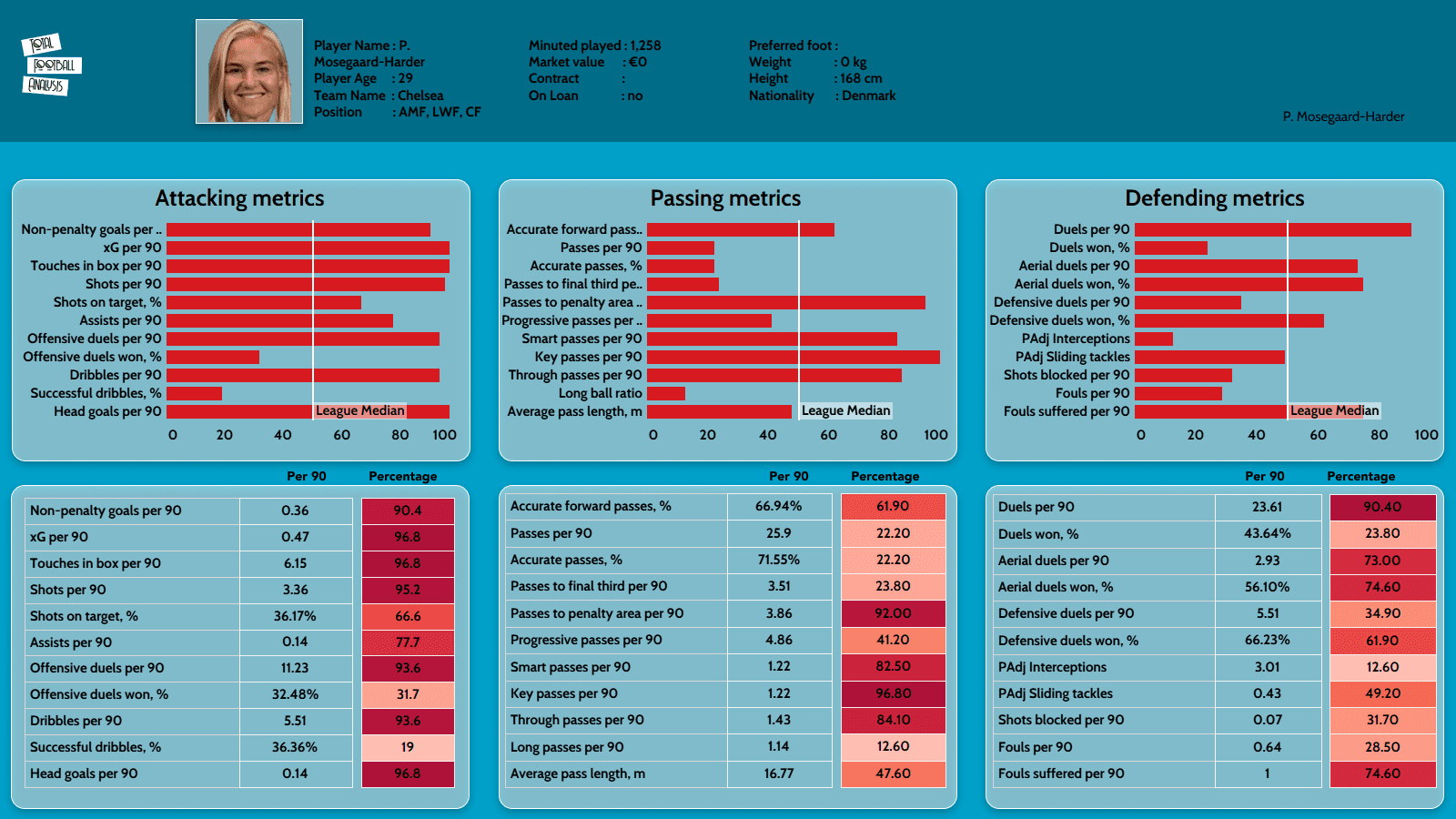
When picking out a key player for Denmark, it is difficult to look past their talismanic attacker and the country’s record goalscorer (men’s and women’s), Chelsea’s Pernille Harder. As this graphic (breaking down her domestic performances for the last calendar year and comparing her statistics in each noted area with the league median) illustrates, the versatile forward ranks above the league median for the majority of attacking statistics, which is not surprising given that she is their focal point and target player, therefore having plenty of goalscoring opportunities.
However, there are a couple of statistics in which Harder is lower than the median — offensive duels won and successful dribbles. The reason for offensive duels being below the median is that in recent years, she has operated in the central role for her nation, so winning balls back has not been her primary role on the pitch. As she is in the final third more often than not, she also doesn’t make many dribbles, with there not being much distance between her and the opposing goal, so this explains why that also doesn’t rank as highly.
When passing, Harder’s long ball ratio being lower is again due to Denmark’s style of play, as the ball is played into her across shorter distances and her teammates are in close proximity to her, meaning that she then doesn’t need to cover long distances to find them. However, the fact that her key passes per 90 are in the top band when compared to others in her position indicates how, when she does move the ball around the pitch, it tends to be effective and lead to something, which explains why she is such an important player and is her country’s captain.
Defensively, Harder’s role is not hugely focused on attempting interceptions or winning duels, which is why these values are lower than the league median. However, she does offer something in this section of the graphic with her aerial duels won ranking highly, and this shows how she is strong in the air and a good target player for her team. Having her at the top of the pitch will enable Denmark to play a more direct style of play if needed, again highlighting their adaptability and Harder’s importance to that.
Tournament Prediction
Given the points made in this tactical analysis, we must conclude that Denmark are capable of competing in this tournament and in all likelihood will do so, but we also need to remember that they are in a tough group with some very tricky opposition, which may dampen expectations slightly. Their hopes of progressing deep into the tournament won’t be helped by the fitness questions of Pernille Harder, given her obvious importance to the team. However, in their three games so far in 2022, Harder has not been as involved in the squad, so Denmark have proven that they can play without her and still deliver good performances to gain results.
The concern will be that their wins came against ‘weaker’ opposition in Azerbaijan and Malta, but they lost to Italy in the Algarve Cup before being forced to withdraw from the tournament. Therefore, the question is: can they compete with those on the same playing level as them?
If they can find their attacking quality and control games, then Denmark have a very real chance of being competitive. How far they progress will depend on whether they can sustain that momentum, but fans should have hope that they will make it to the knockout rounds at the very least.

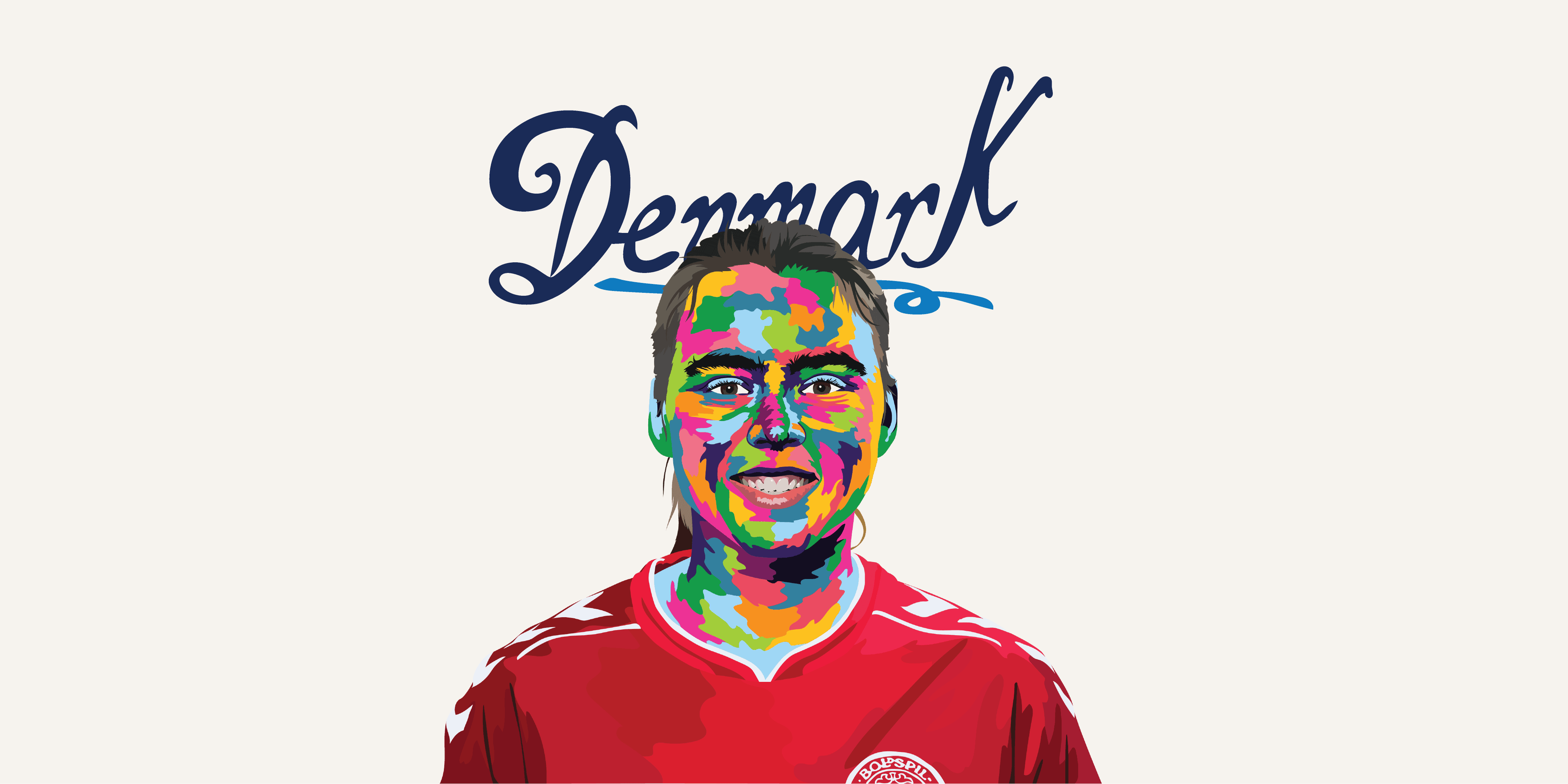



Comments